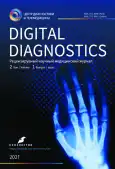Эталонные медицинские датасеты (MosMedData) для независимой внешней оценки алгоритмов на основе искусственного интеллекта в диагностике
- Авторы: Павлов Н.А.1, Андрейченко А.Е.1, Владзимирский А.В.1, Ревазян А.А.1, Кирпичев Ю.С.1, Морозов С.П.1
-
Учреждения:
- Научно-практический клинический центр диагностики и телемедицинских технологий Департамента здравоохранения г. Москвы
- Выпуск: Том 2, № 1 (2021)
- Страницы: 49-66
- Раздел: Технические отчеты
- URL: https://journals.rcsi.science/DD/article/view/60635
- DOI: https://doi.org/10.17816/DD60635
- ID: 60635
Цитировать
Аннотация
В статье описывается оригинальный подход к формированию аннотированных медицинских датасетов для проверки диагностических решений, основанных на технологиях искусственного интеллекта. Описаны 4 этапа формирования датасета ― планирование, отбор исходных данных, разметка и верификация, документирование. Приведены примеры созданных по описанной методике датасетов. Методика является масштабируемой и универсальной, а значит, может быть использована в других областях медицины и здравоохранения, которые подлежат автоматизации и развитию с помощью технологий искусственного интеллекта и технологий больших данных.
Ключевые слова
Полный текст
Открыть статью на сайте журналаОб авторах
Николай Александрович Павлов
Научно-практический клинический центр диагностики и телемедицинских технологий Департамента здравоохранения г. Москвы
Автор, ответственный за переписку.
Email: n.pavlov@npcmr.ru
ORCID iD: 0000-0002-4309-1868
SPIN-код: 9960-4160
https://pavlov.rocks
Россия, 109029, Москва, ул. Средняя Калитниковская, д. 28
Анна Евгеньевна Андрейченко
Научно-практический клинический центр диагностики и телемедицинских технологий Департамента здравоохранения г. Москвы
Email: a.andreychenko@npcmr.ru
ORCID iD: 0000-0001-6359-0763
SPIN-код: 6625-4186
к.ф.-м.н.
Россия, 109029, Москва, ул. Средняя Калитниковская, д. 28Антон Вячеславович Владзимирский
Научно-практический клинический центр диагностики и телемедицинских технологий Департамента здравоохранения г. Москвы
Email: a.vladzimirsky@npcmr.ru
ORCID iD: 0000-0002-2990-7736
SPIN-код: 3602-7120
д.м.н.
Россия, 109029, Москва, ул. Средняя Калитниковская, д. 28Ануш Артуровна Ревазян
Научно-практический клинический центр диагностики и телемедицинских технологий Департамента здравоохранения г. Москвы
Email: anushrevazyan@gmail.com
ORCID iD: 0000-0003-1589-2382
Россия, 109029, Москва, ул. Средняя Калитниковская, д. 28
Юрий Сергеевич Кирпичев
Научно-практический клинический центр диагностики и телемедицинских технологий Департамента здравоохранения г. Москвы
Email: y.kirpichev@npcmr.ru
ORCID iD: 0000-0002-9583-5187
SPIN-код: 3362-3428
Россия, 109029, Москва, ул. Средняя Калитниковская, д. 28
Сергей Павлович Морозов
Научно-практический клинический центр диагностики и телемедицинских технологий Департамента здравоохранения г. Москвы
Email: morozov@npcmr.ru
ORCID iD: 0000-0001-6545-6170
SPIN-код: 8542-1720
д.м.н., профессор
Россия, 109029, Москва, ул. Средняя Калитниковская, д. 28Список литературы
- Гусев А.В. Перспективы нейронных сетей и глубокого машинного обучения в создании решений для здравоохранения // Врач и информационные технологии. 2017. № 3. С. 92–105.
- Ranschaert E.R., Morozov S., Algra P.R., eds. Artificial intelligence in medical imaging. Cham: Springer International Publishing; 2019. doi: 10.1007/978-3-319-94878-2
- Griffith B., Kadom N., Straus C.M. Radiology Education in the 21st Century: Threats and Opportunities // J Am Coll Radiol. 2019. Vol. 16, N 10. Р. 1482–1487. doi: 10.1016/j.jacr.2019.04.003
- Savadjiev P., Chong J., Dohan A., et al. Demystification of AI-driven medical image interpretation: past, present and future // European Radiology. 2019. Vol. 29. N 3, Р. 1616–1624. doi: 10.1007/s00330-018-5674-x
- Ng А. What artificial intelligence can and can’t do right now. Harvard Business Review; 2016. Available from: https://hbr.org/2016/11/what-artificial-intelligence-can-and-cant-do-right-now
- Renear H., Sacchi S., Wickett K.M. Definitions of dataset in the scientific and technical literature // Proceedings of the American Society for Information Science and Technology. 2010. Vol. 47, N 1. Р. 1–4. doi: 10.1002/meet.14504701240
- Tan S.L., Gao G., Koch S. Big data and analytics in healthcare // Methods Inf Med. 2015. Vol. 54, N 6. Р. 546–547. doi: 10.3414/ME15-06-1001
- Kohli M.D., Summers R.M., Geis J.R. Medical image data and datasets in the era of machine learning—whitepaper from the 2016 C-MIMI meeting dataset session // J Digit Imaging. 2017. Vol. 30, N 4. Р. 392–399. doi: 10.1007/s10278-017-9976-3
- Willemink M.J., Koszek W.A., Hardell C., et al. Preparing medical imaging data for machine learning // Radiology. 2020. Vol. 295, N 1. Р. 4–15. doi: 10.1148/radiol.2020192224
- Морозов С.П., Шелехов П.В., Владзимирский А.В. Современные стандартизованные подходы к совершенствованию службы лучевой диагностики // Проблемы стандартизации в здравоохранении. 2019. № 5-6. С. 30–34. doi: 10.26347/1607-2502201905-06030-034
- Kulberg N.S., Gusev M.A., Reshetnikov R.V., et al. Methodology and tools for creating training samples for artificial intelligence systems for recognizing lung cancer on CT images // Health Care Russian Federation. 2021. Vol. 64, N 6. Р. 343–350. doi: 10.46563/0044-197x-2020-64-6-343-350
- Preston-Werner T. Semantic Versioning 2.0.0 [Internet]. Available from: https://semver.org
- Морозов С.П., Проценко Д.Н., Сметанина С.В. и др. Лучевая диагностика коронавирусной болезни (COVID-19): организация, методология, интерпретация результатов : препринт № ЦДТ ― 2020 ― II. Версия 2 от 17.04.2020. Серия «Лучшие практики лучевой и инструментальной диагностики». Вып. 65. Москва : ГБУЗ НПКЦ ДиТ ДЗМ, 2020. 80 с. Режим доступа: https://tele-med.ai/biblioteka-dokumentov/luchevaya-diagnostika-koronavirusnoj-bolezni-covid-19-organizaciya-metodologiya-interpretaciya-rezultatov. Дата обращения: 15.01.2021.
- Pavlov N. ECR 2021: Value of technical stratification of medical datasets for AI services. Moscow, 2021. [Internet]. Available from: https://connect.myesr.org/course/ai-in-breast-imaging/
- Морозов С.П., Владзимирский А.В., Ледихова Н.В. и др. Московский эксперимент по применению компьютерного зрения в лучевой диагностике: вовлеченность врачей-рентгенологов // Врач и информационные технологии. 2020. № 4. С. 14–23. doi: 10.37690/1811-0193-2020-4-14-23
- Morozov S.P., Vladzymyrskyy A.V., Klyashtornyy V.G., et al. Clinical acceptance of software based on artificial intelligence technologies (radiology). Series «Best practices in medical imaging». Issue 57. Moscow; 2019. 45 p.
- Morozov S.P., Andreychenko A.E., Pavlov N.A., et al. MosMedData: Chest CT scans with COVID-19 related findings dataset // medRxiv. 2020. doi: 10.1101/2020.05.20.20100362
- Sushentsev N., Bura V., Kotniket M., et al. A head-to-head comparison of the intra- and interobserver agreement of COVID-RADS and CO-RADS grading systems in a population with high estimated prevalence of COVID-19 // BJR Open. 2020. Vol. 2, N 1. Р. 20200053. doi: 10.1259/bjro.20200053
- Jin C., Chen W., Caoet Y., et al. Development and evaluation of an artificial intelligence system for COVID-19 diagnosis // Nat Commun. 2020. Vol. 11, N 1. Р. 5088. doi: 10.1038/s41467-020-18685-1
Дополнительные файлы














